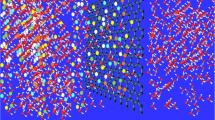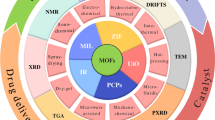Abstract
Arsenic in groundwater poses serious health risks. Over the last decade, adhering to World Health Organization (WHO) directives, permissible arsenic levels in drinking water were reduced, requiring efficient, cost-effective, and user-friendly technologies. In this work, a hybrid nanocomposite membrane (HNM) with adsorbent mesoporous silica nanoparticles (MSN) covalently linked to organic electrospun nanofibers was developed. MSN were synthesised and superficially modified in order to be physically and chemically effective for both the conformation of the HNM and the adsorption of arsenic(V). Materials were structurally characterised by N2 adsorption/desorption, SEM, TEM, TGA, FTIR and evaluated for As(V) removal in synthetic and real groundwater samples at pH 8. In synthetic solutions, HNM lowers arsenic below WHO limits in less than 60 min, showing very fast adsorption kinetic during the first 15 min. The adsorption mechanism adheres to a pseudo-second-order reaction, signifying the chemical bonding of As(V) to active sites. Also, Langmuir model aligns with the adsorption isotherm, indicating surface saturation with a monolayer of arsenate species. HNM sustains capacity (>94%) over five adsorption/desorption cycles, enhancing viability for reuse. When exposed to real contaminated water, HNM achieves more than 60% adsorption within 60 min and 90% surface regeneration, an outstanding result for the treatment of real environmental samples without prior treatments. Therefore, this hybrid nanocomposite membrane offers an effective and viable alternative for the removal of arsenate ions from contaminated water. These outcomes could forward the design of new treatment devices with an effective and environmentally acceptable technology for arsenic removal.
Graphical Abstract

Highlights
-
A new generation of reusable adsorbents is presented as an alternative to conventional technologies to remove arsenic from groundwater.
-
Hybrid nanocomposite membrane (HNM) is successfully conformed through a crosslinking process between mesoporous silica nanoparticles and electrospun polyacrylonitrile nanofibers.
-
The adsorbent exhibits high and fast adsorption capacity for arsenate ions over multiple cycles of use and regeneration.
-
Hybrid nanocomposite membranes (HNM) exhibit high adsorption efficiency in real arsenic-contaminated water matrices.









Similar content being viewed by others
References
Mandal BK, Suzuki KT (2002) Arsenic round the world: a review. Talanta 58:201–235
Smedley PL, Kinnirugh DG (2013) Chapter 12: Arsenic in goundwater and the environment. In: Selinus O, Alloway B, Centeno JA, et al. (eds.), Essentials of medical geology. Springer, pp 279–310. https://nora.nerc.ac.uk/502491/1/SmedleyMedicalGeology_Arsenic2013.pdf
Shaji E, Santosh M, Sarath KV et al. (2021) Arsenic contamination of groundwater: a global synopsis with focus on the Indian Peninsula. Geosci Front 12:101079. https://doi.org/10.1016/j.gsf.2020.08.015
Bundschuh J, Litter MI, Parvez F et al. (2012) One century of arsenic exposure in Latin America: a review of history and occurrence from 14 countries. Sci Total Environ 429:2–35
Bhattacharya P, Claesson M, Bundschuh J et al. (2006) Distribution and mobility of arsenic in the Río Dulce alluvial aquifers in Santiago del Estero Province, Argentina. Sci Total Environ 358:97–120. https://doi.org/10.1016/j.scitotenv.2005.04.048
Litter MI (2010) La problemática del arsénico en la Argentina: el HACRE. Rev Soc Argent Endocrinol Ginecol Reprod (SAEGRE) 17:5–10
Bardach AE, Ciapponi A, Soto N et al. (2015) Epidemiology of chronic disease related to arsenic in Argentina: a systematic review. Sci Total Environ 538:802–816
Mohammed Abdul KS, Jayasinghe SS, Chandana EPS et al. (2015) Arsenic and human health effects: a review. Environ Toxicol Pharm 40:828–846. https://doi.org/10.1016/j.etap.2015.09.016
(IARC) IA for R in C (2004) Arsenic in drinking water
WHO (2017) World Health Organization, Guidelines for drinking-water quality – 4th edition incorporanting the first addendum
USEPA National primary drinking water regulations, Arsenic and clarifications to compliance and new source contaminants monitoring, Final rule Federal Register
Liu B, Kim K-H, Kumar V, Kim S (2020) A review of functional sorbents for adsorptive removal of arsenic ions in aqueous systems. J Hazard Mater 388:121815. https://doi.org/10.1016/j.jhazmat.2019.121815
Litter MI, Ingallinella AM, Olmos V et al. (2019) Arsenic in Argentina: technologies for arsenic removal from groundwater sources, investment costs and waste management practices. Sci Total Environ 690:778–789. https://doi.org/10.1016/j.scitotenv.2019.06.358
Moreira VR, Lebron YAR, Santos LVS et al. (2021) Arsenic contamination, effects and remediation techniques: a special look onto membrane separation processes. Process Saf Environ Prot 148:604–623. https://doi.org/10.1016/j.psep.2020.11.033
Kumar R, Patel M, Singh P, et al. (2019) Emerging technologies for arsenic removal from drinking water in rural and peri-urban areas: methods, experience from, and options for Latin America. Sci Total Environ 694. https://doi.org/10.1016/j.scitotenv.2019.07.233
Sahoo TR, Prelot B (2020) Chapter 7 – Adsorption processes for the removal of contaminants from wastewater: the perspective role of nanomaterials and nanotechnology. In: Bonelli B, Freyria FS, Rossetti I, Sethi RBT-N for the D and R of WP (eds) Micro and nano technologies. Elsevier, pp 161–222
Lata S, Samadder SR (2016) Removal of arsenic from water using nano adsorbents and challenges: a review. J Environ Manag 166:387–406. https://doi.org/10.1016/j.jenvman.2015.10.039
Awual MR, Hossain MA, Shenashen MA et al. (2013) Evaluating of arsenic(V) removal from water by weak-base anion exchange adsorbents. Environ Sci Pollut Res 20:421–430. https://doi.org/10.1007/s11356-012-0936-7
Awual MR, Shenashen MA, Yaita T et al. (2012) Efficient arsenic(V) removal from water by ligand exchange fibrous adsorbent. Water Res 46:5541–5550. https://doi.org/10.1016/j.watres.2012.07.038
Awual MR, Yaita T, Suzuki S, Shiwaku H (2015) Ultimate selenium(IV) monitoring and removal from water using a new class of organic ligand based composite adsorbent. J Hazard Mater 291:111–119. https://doi.org/10.1016/j.jhazmat.2015.02.066
Awual MR, Hasan MM, Asiri AM, Rahman MM (2019) Cleaning the arsenic(V)contaminated water for safe-guarding the public health using novel composite material. Compos B Eng 171:294–301. https://doi.org/10.1016/j.compositesb.2019.05.078
Awual MR (2019) Efficient phosphate removal from water for controlling eutrophication using novel composite adsorbent. J Clean Prod 228:1311–1319. https://doi.org/10.1016/j.jclepro.2019.04.325
Yohai L, Giraldo Mejía H, Procaccini R et al. (2019) Nanocomposite functionalized membranes based on silica nanoparticles cross-linked to electrospun nanofibrous support for arsenic(v) adsorption from contaminated underground water. RSC Adv 9:8280–8289. https://doi.org/10.1039/C8RA09866B
Salazar H, Martins PM, Valverde A, et al. (2021) Reusable nanocomposite membranes for highly efficient arsenite and arsenate dual removal from water. Adv Mater Interfaces. https://doi.org/10.1002/admi.202101419
Martins PM, Santos B, Salazar H, et al. (2022) Multifunctional hybrid membranes for photocatalytic and adsorptive removal of water contaminants of emerging concern. Chemosphere 293. https://doi.org/10.1016/j.chemosphere.2022.133548
Schwartz FW, Zhang H (2003) Fundamentals of groundwater. John Wiley & Sons, New York
Tarn D, Ferris DP, Barnes JC et al. (2014) A reversible light-operated nanovalve on mesoporous silica nanoparticles. Nanoscale 6:3335–3343. https://doi.org/10.1039/C3NR06049G
Schwanke AJ, Lopes CW, Pergher SBC (2013) Synthesis of mesoporous material from chrysotile-derived silica. Mater Sci Appl 04:68–72. https://doi.org/10.4236/msa.2013.48A009
Goyal PS, Dasannacharya BA, Kelkar VK et al. (1991) Shapes and sizes of micelles in CTAB solutions. Phys B Condens Matter 174:196–199. https://doi.org/10.1016/0921-4526(91)90606-F
Patel V, Dharaiya N, Ray D et al. (2014) pH controlled size/shape in CTAB micelles with solubilized polar additives: a viscometry, scattering and spectral evaluation. Colloids Surf A Physicochem Eng Asp 455:67–75. https://doi.org/10.1016/j.colsurfa.2014.04.025
Gibson LT (2014) Mesosilica materials and organic pollutant adsorption: part A removal from air. Chem Soc Rev 43:5163–5172. https://doi.org/10.1039/C3CS60096C
Sing KSW (1985) Reporting physisorption data for gas/solid systems with special reference to the determination of surface area and porosity (Recommendations 1984). Pure Appl Chem 57:603–619. https://doi.org/10.1351/pac198557040603
Horňáček M, Hudec P, Smiešková A (2009) Synthesis and characterization of mesoporous molecular sieves. Chem Pap 63:689–697. https://doi.org/10.2478/s11696-009-0066-y
Sheikh MC, Hasan MM, Hasan MN, et al. (2023) Toxic cadmium(II) monitoring and removal from aqueous solution using ligand-based facial composite adsorbent. J Mol Liq 389. https://doi.org/10.1016/j.molliq.2023.122854
Awual MR, Hasan MN, Hasan MM, et al. (2023) Green and robust adsorption and recovery of Europium(III) with a mechanism using hybrid donor conjugate materials. Sep Purif Technol 319. https://doi.org/10.1016/j.seppur.2023.124088
Rasee AI, Awual E, Rehan AI, et al. (2023) Efficient separation, adsorption, and recovery of Samarium(III) ions using novel ligand-based composite adsorbent. Surf Interfaces 41. https://doi.org/10.1016/j.surfin.2023.103276
Innocenzi P (2003) Infrared spectroscopy of sol–gel derived silica-based films: a spectra-microstructure overview. J Non Cryst Solids 316:309–319. https://doi.org/10.1016/S0022-3093(02)01637-X
Rosero-Navarro NC, Pellice SA, Castro Y et al. (2009) Improved corrosion resistance of AA2024 alloys through hybrid organic–inorganic sol–gel coatings produced from sols with controlled polymerisation. Surf Coat Technol 203:1897–1903. https://doi.org/10.1016/j.surfcoat.2009.01.019
Kleitz F, Schmidt W, Schüth F (2003) Calcination behavior of different surfactant-templated mesostructured silica materials. Microporous Mesoporous Mater 65:1–29. https://doi.org/10.1016/S1387-1811(03)00506-7
Nhavene EP, Andrade GF, Faria JA et al. (2018) Biodegradable polymers grafted onto multifunctional mesoporous silica nanoparticles for gene delivery. ChemEngineering 2(2):24. https://doi.org/10.3390/chemengineering2020024
Lim A, Song M-H, Cho C-W, Yun Y-S (2016) Development of surface-modified polyacrylonitrile fibers and their selective sorption behavior of precious metals. Appl Sci 6:378. https://doi.org/10.3390/app6120378
Yoshitake H, Yokoi T, Tatsumi T (2002) Adsorption of chromate and arsenate by amino-functionalized MCM-41 and SBA-1. Chem Mater 14:4603–4610
Ho Y-S (2006) Review of second-order models for adsorption systems. J Hazard Mater 136:681–689. https://doi.org/10.1016/j.jhazmat.2005.12.043
Ayawei N, Angaye S, Wankasi D, Dikio E (2015) Synthesis, characterization and application of Mg/Al layered double hydroxide for the degradation of Congo Red in aqueous solution. Open J Phys Chem 5:56–70. https://doi.org/10.4236/ojpc.2015.53007
Zuo JC, Tong SR, Yu XL et al. (2012) Fe 3+ and amino functioned mesoporous silica: preparation, structural analysis and arsenic adsorption. J Hazard Mater 235–236:336–342. https://doi.org/10.1016/j.jhazmat.2012.08.009
Rehan AI, Rasee AI, Awual ME, et al. (2023) Improving toxic dye removal and remediation using novel nanocomposite fibrous adsorbent. Colloids Surf A Physicochem Eng Asp 673. https://doi.org/10.1016/j.colsurfa.2023.131859
ANMAT Capítulo XII- Bebidas Hídricas, Agua y Agua Gasificadas. In: Código Alimentario Argentino. p Artículos: 982 al 1079
Acknowledgements
This work was supported by the Agencia Nacional de Promoción Científica y Tecnológica (PICT 2019-0565), the Consejo Nacional de Investigaciones Científicas y Técnicas (PIBAA 2022-1004 and PIP 2022-0857) and Nanoremovas Project: H2020-MSCA-RISE-2014 [grant number 645024], “Advanced multifunctional nanostructured materials applied to remove arsenic in Argentinian groundwater”. The authors would like to thank Montserrat Resina Gallego for her valuable technical support.
Author information
Authors and Affiliations
Contributions
LY: experimental work, writing—original draft, methodology, data curation. AU: methodology, supervision, writing—review. SP: experimental work, writing—original draft, methodology, supervision, writing—review.
Corresponding author
Ethics declarations
Conflict of interest
The authors declare no competing interests.
Additional information
Publisher’s note Springer Nature remains neutral with regard to jurisdictional claims in published maps and institutional affiliations.
Supplementary Information
Rights and permissions
Springer Nature or its licensor (e.g. a society or other partner) holds exclusive rights to this article under a publishing agreement with the author(s) or other rightsholder(s); author self-archiving of the accepted manuscript version of this article is solely governed by the terms of such publishing agreement and applicable law.
About this article
Cite this article
Yohai, L., Uheida, A. & Pellice, S. Nanoparticle-nanofiber synergistic matrix for highly effective arsenic adsorption: material design and performance evaluation. J Sol-Gel Sci Technol 109, 385–399 (2024). https://doi.org/10.1007/s10971-023-06277-6
Received:
Accepted:
Published:
Issue Date:
DOI: https://doi.org/10.1007/s10971-023-06277-6




